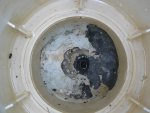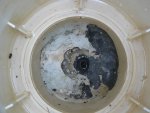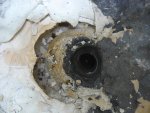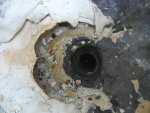About every year, I've had to repair leaks in the bottom of the skimmer, using epoxy each time. The first time, I noticed that it had also been done before (we're not original owners). Now I was having a harder time detecting a leak, and thought it might be down the pipe a bit, as previously I'd had to go down it with epoxy to also seal a leak. But now I'm getting concerned that the pipe opening is getting too small if I repair it again with another layer.
So, I decided to pull up some of the older layers of epoxy, which occasionally had come up when checking for leaks. Well, now I apparently overdid it. I'm not sure what it looked like pre-first repair, though I'm guessing it was a fiberglass bottom (with a pipe coming up into it?) But I seem to have pulled up that bottom, too, and don't know if I can try to repair with epoxy (see photos - it's now not a crack, but a hole), or if I should try some fiberglass repair of some sort, or if I have to call in a pro.
Also, I still never got the epoxy repair that went down into the pipe/tube pulled up, but stopped when I saw how much of a repair I had to do, and not wanting to make it worse.
Any and all advice feedback would be much appreciated!


So, I decided to pull up some of the older layers of epoxy, which occasionally had come up when checking for leaks. Well, now I apparently overdid it. I'm not sure what it looked like pre-first repair, though I'm guessing it was a fiberglass bottom (with a pipe coming up into it?) But I seem to have pulled up that bottom, too, and don't know if I can try to repair with epoxy (see photos - it's now not a crack, but a hole), or if I should try some fiberglass repair of some sort, or if I have to call in a pro.
Also, I still never got the epoxy repair that went down into the pipe/tube pulled up, but stopped when I saw how much of a repair I had to do, and not wanting to make it worse.
Any and all advice feedback would be much appreciated!





